Newsstand Period 1922 - 1955
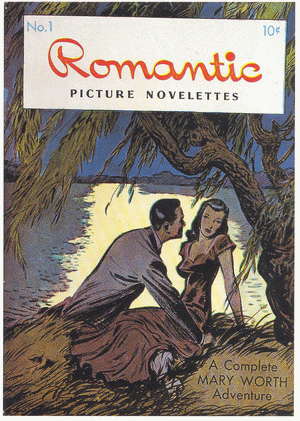 Former DC Editor Vin Sullivan would start up a company called
Magazine Enterprises in 1944. In 1946 he would publish a one shot comic
that would later become a major genre. The comic was called Romantic
Picture Novelettes #1. Inside were reprints of the Mary Worth comic
strip. This would be the first time a title was devoted to romance tales.
Former DC Editor Vin Sullivan would start up a company called
Magazine Enterprises in 1944. In 1946 he would publish a one shot comic
that would later become a major genre. The comic was called Romantic
Picture Novelettes #1. Inside were reprints of the Mary Worth comic
strip. This would be the first time a title was devoted to romance tales.
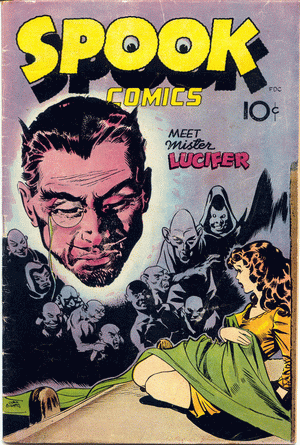 There was a couple of early 1 shot attempts at doing horror comics
prior the genre really taking off. The first was Spook Comics #1 by Baily Publications. It came out in
1946 featuring a Mister Lucifer story. The horror tale starts when some crooks on the run try to stash their loot
in a graveyard coffin. The crooks unknowingly release Mister Lucifer who had been captured in there thanks
to the tombstone. Lucifer is of course, the devil and he summons up spirits to do his evil deeds. They
go around wreaking havoc on mankind until he accidentally falls into wet cement, incasing him in a new
"tombstone." After this are three comedy stories involving ghosts, zombies and a haunted house. The last
story is about a Haitian Voodoo dancer casting spells amidst a nightclub war. This was the very first all anthology
horror comic book, but it was only a one shot. There are no credits in the book, except for the cover by
John Giunta. This book is also an example of a temporary war time restriction on comics. To save metal for
the war effort, comics were printed with only one staple in the middle of it, this was the case for many
comics in around 1946-1947.
There was a couple of early 1 shot attempts at doing horror comics
prior the genre really taking off. The first was Spook Comics #1 by Baily Publications. It came out in
1946 featuring a Mister Lucifer story. The horror tale starts when some crooks on the run try to stash their loot
in a graveyard coffin. The crooks unknowingly release Mister Lucifer who had been captured in there thanks
to the tombstone. Lucifer is of course, the devil and he summons up spirits to do his evil deeds. They
go around wreaking havoc on mankind until he accidentally falls into wet cement, incasing him in a new
"tombstone." After this are three comedy stories involving ghosts, zombies and a haunted house. The last
story is about a Haitian Voodoo dancer casting spells amidst a nightclub war. This was the very first all anthology
horror comic book, but it was only a one shot. There are no credits in the book, except for the cover by
John Giunta. This book is also an example of a temporary war time restriction on comics. To save metal for
the war effort, comics were printed with only one staple in the middle of it, this was the case for many
comics in around 1946-1947.
Spook Comics #1 is in the public domain and you can download and read it by clicking here. (35.1 MB - Scanned Paper)
In January of 1947 Avon Comics Group would publish Eerie Comics.
After the horror genre became popular they would restart Eerie in 1951 and give it a full series. The first
issue would reprint the 1947 one shot and continue from there until issue #18 where the title changed
to Strange Worlds. In the future Horror would become a very big genre in comic industry. The horror
comics would draw a lot of negative attention from those wanting to protect their children. More on
that later.
Eerie Comics #1 is in the public domain and you can download and read it by clicking here. (32 MB - Scanned Paper)
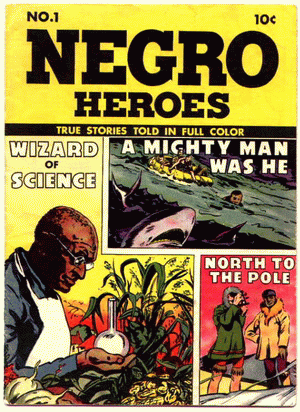 There were a few attempts to make comic books for African Americans during this period. Usually in comics
black people were portrayed as dumb, man-children often played up for laughs. They were also drawn with big
eyes and lips and other unsavory features. But a few publishers did comic books with more positive
portrayals. Parents Magazine Institute published Negro Heroes in spring of 1947, but the title would
only go two issues. In it were reprints from their other titles (Calling All Girls, Real Life and True
Comics) featuring black people.
All Negro Comics was done by a
black publisher named Orrin C. Evans,
a very well respected black journalist. Inside was a mix of heroes and humor, all of it drawn by black
artists. This comic which only went one issue. Then in 1950 Fawcett did
Negro Romance and that title went
4 issues, but the 4th was published in
1955 by Charlton Comics and it was a reprint of the 2nd issue. Other comic publishers have done
comics with black characters as the lead feature, but they rarely last. To this day, comics with black
characters as the main feature have a difficult time attaining commercial success.
There were a few attempts to make comic books for African Americans during this period. Usually in comics
black people were portrayed as dumb, man-children often played up for laughs. They were also drawn with big
eyes and lips and other unsavory features. But a few publishers did comic books with more positive
portrayals. Parents Magazine Institute published Negro Heroes in spring of 1947, but the title would
only go two issues. In it were reprints from their other titles (Calling All Girls, Real Life and True
Comics) featuring black people.
All Negro Comics was done by a
black publisher named Orrin C. Evans,
a very well respected black journalist. Inside was a mix of heroes and humor, all of it drawn by black
artists. This comic which only went one issue. Then in 1950 Fawcett did
Negro Romance and that title went
4 issues, but the 4th was published in
1955 by Charlton Comics and it was a reprint of the 2nd issue. Other comic publishers have done
comics with black characters as the lead feature, but they rarely last. To this day, comics with black
characters as the main feature have a difficult time attaining commercial success.
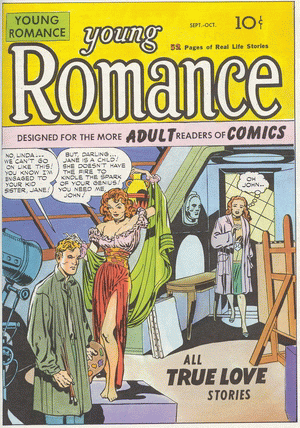 Young Romance #1 by Joe Simon and Jack Kirby came out in
September 1947, published by Prize Comics Group. This is considered to
be the first true romance comic and it was a smash hit. When it first
came out there were no other romance comics so everyone (boy and girl)
interested in love stories bought this comic. The cover advertised
"Designed for the more ADULT readers of COMICS." Inside there were 5
stories titled "I Was a Pick-Up", "The Farmers Wife", "Misguided
Heart", "The Plight of the Suspicious Bride Groom" and "Young Hearts
Sing a Summer Song." As often with Simon and Kirby comics, Simon did
the bulk of the writing and Kirby and Simon together did the artwork.
Unique to comics was the story was told from the female point of view.
Simon wanted the stories to be more complex than typical comic books so
that it would appeal to older audiences as well. When Simon came back
from the army he noticed there were a lot of adults reading kids comics
and he went out to create a comic for adults. He chose the romance
genre because he also saw pulp novels with racy romance stories selling
well. It was easy for him to see that romance was a genre that could be
comics could make money in. Co-creator Jack Kirby said in 1947
everywhere he looked he saw love stories. They were on TV, Movies, and in
Books. The superhero comics fell out of flavour after
WWII was over and they needing something to fill in the gap.
Young Romance #1 by Joe Simon and Jack Kirby came out in
September 1947, published by Prize Comics Group. This is considered to
be the first true romance comic and it was a smash hit. When it first
came out there were no other romance comics so everyone (boy and girl)
interested in love stories bought this comic. The cover advertised
"Designed for the more ADULT readers of COMICS." Inside there were 5
stories titled "I Was a Pick-Up", "The Farmers Wife", "Misguided
Heart", "The Plight of the Suspicious Bride Groom" and "Young Hearts
Sing a Summer Song." As often with Simon and Kirby comics, Simon did
the bulk of the writing and Kirby and Simon together did the artwork.
Unique to comics was the story was told from the female point of view.
Simon wanted the stories to be more complex than typical comic books so
that it would appeal to older audiences as well. When Simon came back
from the army he noticed there were a lot of adults reading kids comics
and he went out to create a comic for adults. He chose the romance
genre because he also saw pulp novels with racy romance stories selling
well. It was easy for him to see that romance was a genre that could be
comics could make money in. Co-creator Jack Kirby said in 1947
everywhere he looked he saw love stories. They were on TV, Movies, and in
Books. The superhero comics fell out of flavour after
WWII was over and they needing something to fill in the gap.
The two would make the entire comic book first to shop around to
the various publishers. They did this so that no publisher could steal
the idea before they got theirs out. Prize Comics, a small publisher
that also owned their own printing press agreed to give Simon and
Kirby 50% of the profits. Simon believes this was the first royalty
agreement for creators in comic books. This issue sold out its original
500,000 print run. It was soon selling 1 million copies a month.
The book was distributed by Independent News, part of the DC Comics companies.
Timely/Marvel Comics owner Martin Goodman complained to Harry
Donenfeld, owner of DC Comics and Independent News about Young Romance. He said the books
were close to being pornographic and it would ruin the industry. Donenfeld
then had Prize remove the "Designed for the more ADULT readers of
COMICS" line from the cover. But due to the high sales many other companies
put out their own romance comics. The first among them would be Martin
Goodman. Between 1948 and 1950 a 'love glut' of titles was produced,
totaling at least 148 different books.
Young Romance ran 208 issues, lasting 29 years.
It would be the most successful of the Romance genre. In the back of most romance
comics would be a kindly advice columnist that would give guidance for
young people who wrote in with their problems. The advice came from
people with comforting names like Nancy Hale, Ray Manm, Amy, and
Adrian. But in reality the advice came from cheap, crusty, 40+ year
old men; the comic book editors. They didn't want to spend money to
hire a real counselor so they did the advice work themselves. Many
teenagers (mostly female) wrote letters to the "columnist" often
telling very intimate and naughty secrets they kept from their parents.
Simon also tried to hire female script writers for the comics, but
didn’t find any one that fit his standards. These days the genre of
romance is usually ignored, with the exception of making parodies of
these types of comics. But don't let that fool you, comics made for
female readers were among the best sellers for many years. The Romance genre and a sizeable female readership made a comeback
in early 2000's, via the Japanese comic (Manga) imports.
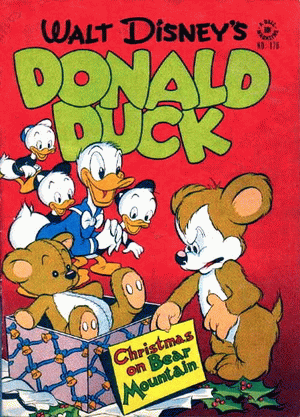 In December 1947, things went in reverse for Disney Comics.
Normally popular Disney cartoon characters would appear in Disney
Comics. Within Four Color Comics #178 Carl Barks would create Uncle
Scrooge McDuck for a story called Christmas on Bear Mountain. The
character was intended to a plot device to help spur a story. He was a
rich old duck who used his money and free time to go on adventures,
usually looking for more money. With him would be his nephews Huey,
Louie, and Dewey and often Donald Duck. But as Barks began doing more
adventure type stories, he used Uncle Scrooge more and more. This
particular story has him using his money to test the Donald Duck’s
courage by offering him a luxurious Christmas Holiday on Bear Mountain.
Uncle Scrooge intended to try and scare Donald with his bear suit, to
prove his belief that Donald was a coward. Scrooge was fooled into
believing Donald was very brave when he saw him "sleeping" beside a
real bear. In reality Donald had fainted.
In December 1947, things went in reverse for Disney Comics.
Normally popular Disney cartoon characters would appear in Disney
Comics. Within Four Color Comics #178 Carl Barks would create Uncle
Scrooge McDuck for a story called Christmas on Bear Mountain. The
character was intended to a plot device to help spur a story. He was a
rich old duck who used his money and free time to go on adventures,
usually looking for more money. With him would be his nephews Huey,
Louie, and Dewey and often Donald Duck. But as Barks began doing more
adventure type stories, he used Uncle Scrooge more and more. This
particular story has him using his money to test the Donald Duck’s
courage by offering him a luxurious Christmas Holiday on Bear Mountain.
Uncle Scrooge intended to try and scare Donald with his bear suit, to
prove his belief that Donald was a coward. Scrooge was fooled into
believing Donald was very brave when he saw him "sleeping" beside a
real bear. In reality Donald had fainted.
Eventually Uncle Scrooge would become Disney Comics most popular
character. He would be given his own comic book and would later make it
on the screen. First he would appear in a Disney special created in
1984, but it was released in 1987. Later on in the same year the Duck
Tales Cartoon starring Uncle Scrooge and his nephews Huey, Louie, and
Dewey would air. The shows popularity would be enough cause to create a
Duck Tales Movie.
 Former DC Editor Vin Sullivan would start up a company called
Magazine Enterprises in 1944. In 1946 he would publish a one shot comic
that would later become a major genre. The comic was called Romantic
Picture Novelettes #1. Inside were reprints of the Mary Worth comic
strip. This would be the first time a title was devoted to romance tales.
Former DC Editor Vin Sullivan would start up a company called
Magazine Enterprises in 1944. In 1946 he would publish a one shot comic
that would later become a major genre. The comic was called Romantic
Picture Novelettes #1. Inside were reprints of the Mary Worth comic
strip. This would be the first time a title was devoted to romance tales. 



